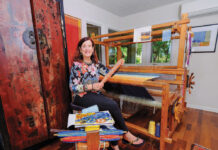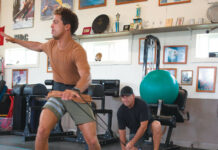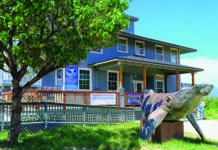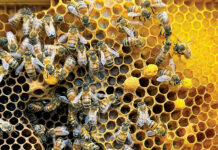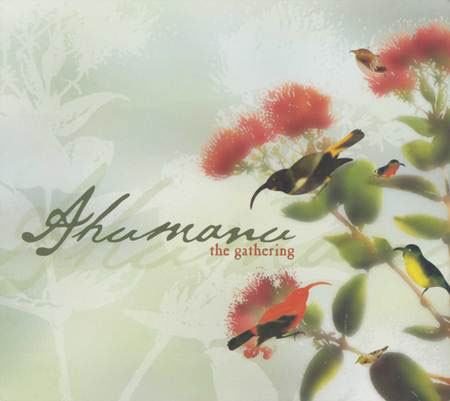 Unwind to Ahumanu
Unwind to Ahumanu
Maui trio Ahumanu’s latest album, The Gathering, brings to mind the golden age of island travel: stately ocean liners, wafting plumeria and Waikiki’s venerable Hawai‘i Calls radio hour.
Liz Morales, Ahumanu’s multitalented front woman, is perhaps best known for her radio alter-ego “Kopa‘a Tita” on KPOA. She and mother-daughter team Joni and Bessie DeMello infuse standards such as Queen Lili‘uokalani’s “Ahe Lau Makani” and Charles King’s “Pua Carnation” with rich, unmistakably feminine harmonies.
The lively instrumental “KP Shuffle” reflects the group’s easygoing side—Liz and Joni composed it as a tribute to Lahaina ‘ukulele artist Ken “KP” Potts in the back of an ‘83 Ford Bronco, driving somewhere between Olowalu and Kahului.
Their band name echoes an interpretation of the Hawaiian word ahumanu. Liz explains,
“We think of it as a gathering of birds.”
The Gathering is ideal to play for pau hana time, or when you just feel like unwinding. As Joni says, “It takes me back to backyard parties . . . playing music our uncles and aunties knew.”
Making their families proud, Ahumanu has received much praise for the album. They were recently nominated for a Na Hoku Hanohano award for Most Promising Artist(s) of the Year.
–Marnie L.R. Masuda
Paddle Like You Mean It
Whether toying around on ankle-snappers or challenging mountains of water, surfing is at least 90 percent paddling. Since the days of the legendary Waikiki Beach Boys, paddleboarding has been the ultimate way for surfers to stay fit and ready for the next swell. This endurance test has remained true through the years—man versus man, and man versus the sea: Duke Kahanamoku regularly paddled his 12-foot wooden board around Diamond Head’s buoy on surfless days; watermen now race across Kaiwi Channel from Moloka‘i to O‘ahu on high-tech, ultra-light carbon-fiber boards.
On Sunday, July 22nd, the Hennessey’s Maui International Paddleboard Championships will host the world’s best paddleboarders, vying for a piece of a $15,000 purse. They will race one of the best courses in the world, too—the nine-mile stretch of coastline from Maliko Gulch to Kahului Harbor, commonly called the “Maliko Run.” Completely exposed to the same blistering trade winds that make Ho‘okipa such an exciting windsurf venue, this course will offer competitors rollicking downwind rides.
The action starts at 1 pm and can best be viewed from the cliffs above Maliko Gulch, from the lookout at Ho‘okipa Beach Park (bring binoculars), or at the finish line at Hawaiian Canoe Club in Kahului Harbor, where a party will greet the finishers. For more information, log on to www.mauipaddleboard.com.
–Blair Thorndike
Mangoes
How do we love them? Let us count the ways: cold and sweet on a sunny beach, messy but delicious over the kitchen sink, green with shoyu and (take your pick) sugar, pepper or vinegar. In jam, pie, bread, chutney, smoothies, as pickles or exotic cocktails. There seems to be no end of ways to enjoy the wonderful mango, now spilling in golden goodness off trees islandwide.
This native of India arrived in Hawai‘i in the early 1800s. The first tree is said to have been planted in Honolulu by Don Francisco de Paula Marin, an enthusiastic gardener and friend of Kamehameha I.
Owners of prolific trees sometimes set boxes full of ripe fruit out by the mailbox, free for the taking. If you’re the one with a tree full of the choice Haden or Pirie varieties, make friends by sharing the bounty.
You haven’t tried mango? Approach it carefully. A member of the same family as poison ivy, the fruit has oils in its skin and leaves that can cause a rash or, in the worst cases, anaphylactic shock. So savor a bite peeled by someone else, and be sure you’re not allergic before diving in for the full mango experience.
—Jill Engledow
Fashion Revolution
I’m walking in Wailuku when something catches my eye. In the window of Bohemia Boutique is the dress—a red-and-white paisley screaming for a beach day. I go inside, lightly clapping my hands with glee. Damage to the wallet? Not much. “I’ll take it,” I say, rushing to the counter before someone else sees it. Bohemia’s new owner, Maggie Bijl—who bought the business last year and relocated from Kahului for better foot traffic—gives a friendly nod.
I ask about the store. “It’s like a flea market, it’s eclectic,” says Bijl. Containing “50 percent new, 50 percent used,” Bohemia is a high-end recycler of shoes, handbags, tops, skirts, jewelry . . . you name it.
Bijl sifts through bags of unwanted clothes daily for gems. (“It’s kind of like panning for gold.”) They aren’t donated; she appraises value according to condition, the season, and the brand. If a piece sells, the consignor gets about half.
Chanel suits, Paul Ropp tunics, Da-Nang pants—clearly Bijl knows style. She attended Illinois Institute of Art and has designed for labels Nautica and Tamara Catz. Asked what appeals to her about fashion, Bijl responds,
“Constant change. If it didn’t evolve, it would get boring.”
Bohemia is located at 105 N. Market St., Wailuku. Call 244-9995 for more information and store hours.
– Kali Speere
Everyone’s Favorite
The Maui onion is a funny little guy—kinda chubby, kinda flaky, but sweet as pie! Maybe that’s why everybody loves him, even those people who usually ask for their burger (gasp!) with “no onions.”
He’s also serious business on Maui, with an entire association named after him (the Maui Onion Growers Association) and a festival, with up to 8,000 visitors, in his honor every summer. The 18th Annual Maui Onion Festival will be held Aug. 4 and 5, from 11 a.m. to 4 p.m. at Whalers Village in Ka‘anapali, featuring onion-eating and recipe contests, an open-air produce market, live entertainment, and celebrity chef demonstrations; and, of course, lots of fried sweet Maui onion rings and other gourmet onion-y creations.
Whalers Village Marketing Manager Lisa Donlon credits the festival’s long-running success to its “ability to bring visitors and locals together.”
“We have Mainlanders talking story with onion farmers as they watch their onion rings being fried, and kids from down the street competing in the onion-eating contest with kids from 5,000 miles away,” Donlon says. “We want people to know that Maui is more than a destination—it’s a place that generates great products and produce.”
The sweetest thing about this festival (besides the little guy): it’s free!
Visit www.whalersvillage.com/active/onion.htm for further details.
– Sky Barnhart

